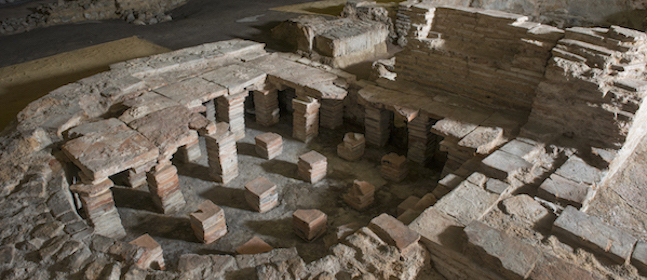Discover Roman London
Step back in time

An ancient underground cult, brutal gladiator games and an indulgent bathhouse...
The modern City of London is located on the site of the ancient Roman settlement of Londinium. The city was founded around 50 AD and occupied until the 4th century when the Romans abandoned Britain. Want to step into the historic world of London’s Roman founders? There are still many traces of Londinium to be discovered and explored all over the modern city. Here’s where to find the ancient settlement’s secret remains…Roman Amphitheatre
In the 1980s, the remains of a 2,000 year-old amphitheatre were discovered under Guildhall Art Gallery in the city of London. You can now see the ruins when you visit the gallery, where there is an exhibition about the events that would have taken place here - from public events to executions and from brutal animal fights to gruesome gladiatorial combat.
(c) Guildhall Art Gallery
The Roman Amphitheatre is at Guildhall Art Gallery off Gresham Street, EC2V 5AE.
The Temple of Mithras at London Mithraeum
Newly opened in winter 2017, the London Mithraeum showcases London's ancient Temple of Mithras. Built about 200 years after the city was founded, the temple has recently been restored in its original location. In Roman times, the temple was used as a place of worship for Roman followers of the ancient cult of Mithras. Followers of Mithras had to prove themselves worthy of joining the cult by progressing through several levels of initiation, marked by tests - although little more is known about the group’s rituals or organisation. The mysterious cult worshiped the bull-killing god Mithras and met in underground temples like the one in London.
(c) James Newton
The Temple of Mithras at London Mithraeum is at Bloomberg Space at 12 Walbrook, EC4N 8AA.
The London Wall
In around 200 AD, a defensive wall was built around the city of Londinium, shaping and protecting the city. At two miles long and around 6 metres high, the wall was one of the largest construction projects carried out in Roman Britain. The course of the ancient wall roughly corresponds to the modern road named London Wall, and remains of the structure - often containing a mix of Roman ruins and medieval sections - can still be seen around the city. The most substantial section of the wall can be seen at Tower Hill, just across from the Tower of London.
The London Wall can be seen at many spots around the City of London, includingoutside the Tower of London.
Billingsgate Roman House and Baths
With hot and cold baths and luxurious underfloor heating, the Billingsgate Roman Baths would once have been a sumptuous place for a relaxing pamper and a gossip. The baths are now some of the best-preserved Roman remains in the city. However, they are only open to the public infrequently, with tours and open days organised by the Museum of London, so you’ll need to plan a visit well in advance!
(c) Museum of London
Billingsgate Roman House and Baths is at 101 Lower Thames Street. Find out about open days and tours.
Roman Exhibits at The British Museum
If visiting these secret Roman remains has given you a taste for Londinium, you can find out more about this ancient civilisation at The British Museum. The museum houses many artifacts and treasures from Roman Britain, with exhibits in their Department of Greece and Rome giving an insight into how Britain became part of Rome while developing its own distinct identity as a province of its Empire, as well as the role that Londinium played in this history.
(c) the Trustees of the British Museum
The British Museum is at Great Russel Street, Bloomsbury, WC1B 3DG.